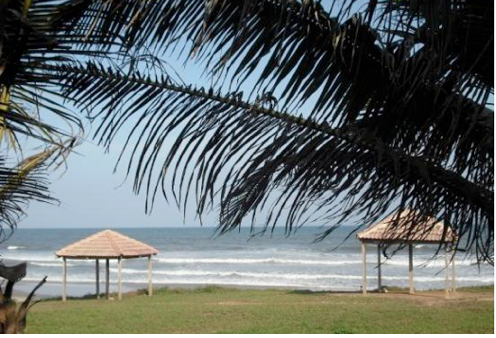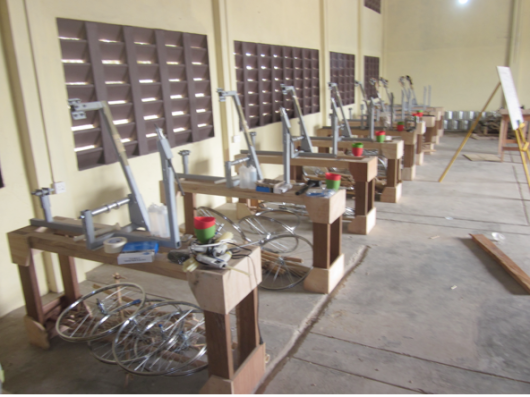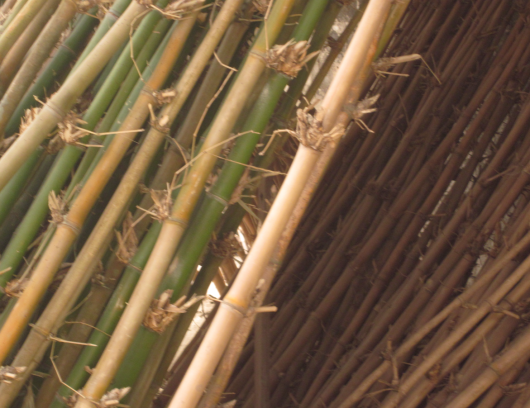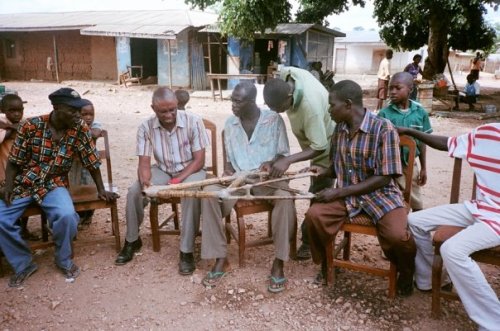[This is part three of a diary that John Mutter, co-founder of the Bamboo Bike Project, kept on a trip to Ghana in January 2011]
Breakfast on the morning of January 13th at the Lamerta consisted of instant coffee, some sort of egg preparation that might almost be an omelet, and sausages accompanied by loud radio station that seemed mostly to be politically oriented and simultaneous TV. The Cecera Guest house where the others are staying is across the street a couple of buildings away and I went there and met them just as they were finishing breakfast.
A pick-up truck came for the team and the three guys went and I stayed because Kwame, who is financing the factory in Kumasi, was coming later and Nicole and I went with him about a half hour later.
The factory is in a semi-residential, semi-industrial area with a few guesthouses and small businesses all on deeply rutted and quite poor dirt roads. No doubt these roads will be improved at some point but it looks like the area has had a period of rapid development that stalled. Very large houses that must belong to fairly wealthy people sit along side very modest places.
Delivery by any large vehicle would be an issue and apparently was a problem when our container with bike parts came yesterday but everything was unloaded onto trucks owned by Bamboo Bikes Limited (Kwame’s company). Now there are 750 sets of rims, associated spokes, cranks, forks etc. available to build bikes. The factory space is in a compound secured by walls and a serous gate.
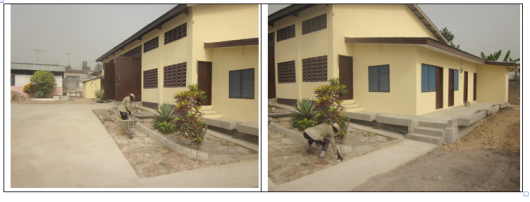
The main facility with the large doors open for access. The management offices are in the right photo. Babaa, who has been hired to improve the grounds is in the scene. In the background is the secondary building where bikes will be stored.
The main facility with the large doors open for access. The management offices are in the right photo. Babaa, who has been hired to improve the grounds is in the scene. In the background is the secondary building where bikes will be stored.
There is one large high ceiling building that is the main space where bikes will be produced. Management offices are exterior to the main building. Apparently the factory, which has houses on either side, was a water sachet factory before. It looks like the storage available would allow about 1000 bike parts and components to be kept in storage.
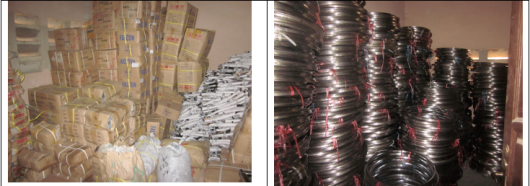
Parts in storage in the rooms inside the main facility
There is a lot of bamboo available stored outside where it is drying but it is harder to judge what storage capacity there is in terms of bike equivalents since not all of it can be used. This is actually not the bamboo that was sent to the US for testing before and we will need to get a sample back and test it.

Outside, the yard is being improved and will have a paved area and some new grassed areas. Right now there is a paved area where cars can come and where a reasonably large truck could make deliveries but not a semi-trailer. Water is from wells in the yard of the factory. There is power from the grid but there is a back-up generator as well. Although the factory is just starting, there is clearly space enough here to support serious production.
The forks that were sent in the container from China have steerer tube lengths shorter than ordered, and that means they do not suite the molds that were made for the lugs for these bikes. Though the metal head tubes can be easily cut down to be suitable, the aluminum molds that were made for this purpose are no longer suitable. So Marty has been busy trying to make a new mold from wood. He has spent a large amount of time on this – even going to the Kumasi Technical Institute (KTI) for help. This way of making a mold requires carving the mold shape from hard wood and goes very slowly.
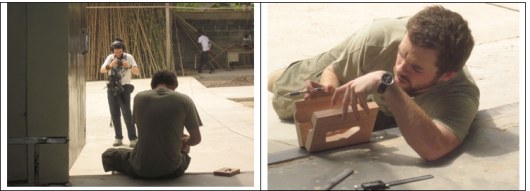
Marty Odlin shaping the mold with Nicole Hahn ever present recording everything. Bamboo storage in the background
The factory has been set up to work on ten bikes at a time. The hope is to have 20 bikes being constructed in parallel and that seems quite reasonable. Certainly there is space for that. There are seven guys who all have qualifications from KTI who have been hired and they form the core of the production team. Today they were involved in three main activities. In the morning they were selecting and cutting bamboo from the storage area. There is a very good electric saw for this that makes the job quite quick and the cuts are clean and straight. The small shoots that come out of many of the stalks at the nodes need to be trimmed and this is done with a handsaw.
At the same time they were smoothing the joints on two bikes that were built from starter kits the previous day. This involves sanding and filing both for the purposes of making a smooth appearance but also because irregularities have the effect of concentrating stress that might generate weak points that could eventually lead to failure.
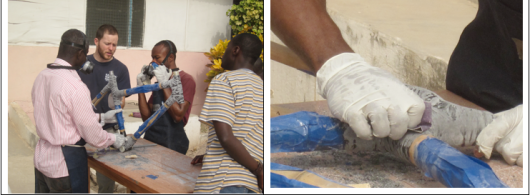
Ben showing members of the Ghanaian team the art of smoothing the joints with a detail on the right
We walked to lunch at a local roadside vendor where everyone had local food items prepared there.
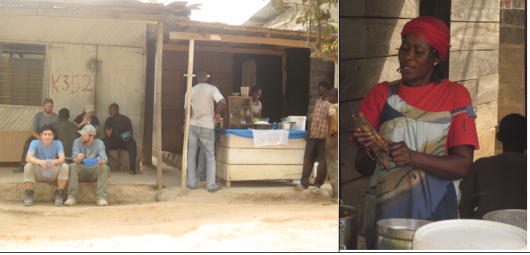
The afternoon was involved in training the crew in wheel building. The wheels were sent as hubs, rims and spokes separately and need to bebuilt up by the team. Once people gain the skills this can be done in 15 minutes or so. Ben first demonstrated the process and then each of the builders built one for themselves under Ben’s guidance. This is a non-trivial task and takes some practice but as I watched it was obvious these guys were getting the idea pretty quickly and that’s very encouraging.
At the end of the day everyone had built a wheel and that counts as quite an achievement. There are many, many people working in bike shops in the US who can’t build a wheel. None of these guys had come close to doing anything like this before and it is a real delight to see them doing so well at it. Many of them travel a long way to get to the factory, taking as much as an hour and a half. They are keen and enthusiastic and have the skills to build bikes, no doubt about that.
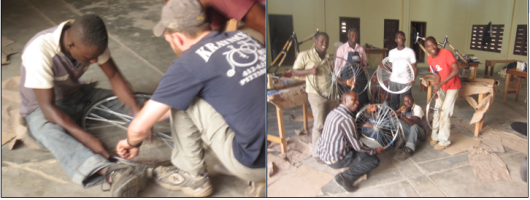
Ben training one of the crew in wheel-making, and at the end of the day everyone has built a wheel
The only news that is not so great is that the container from Brooklyn with tools and jigs and the other things needed to build bikes has not arrived. The consistent word is that it will arrive tomorrow morning. If it does not we will start running out of things to do for training fairly soon.
